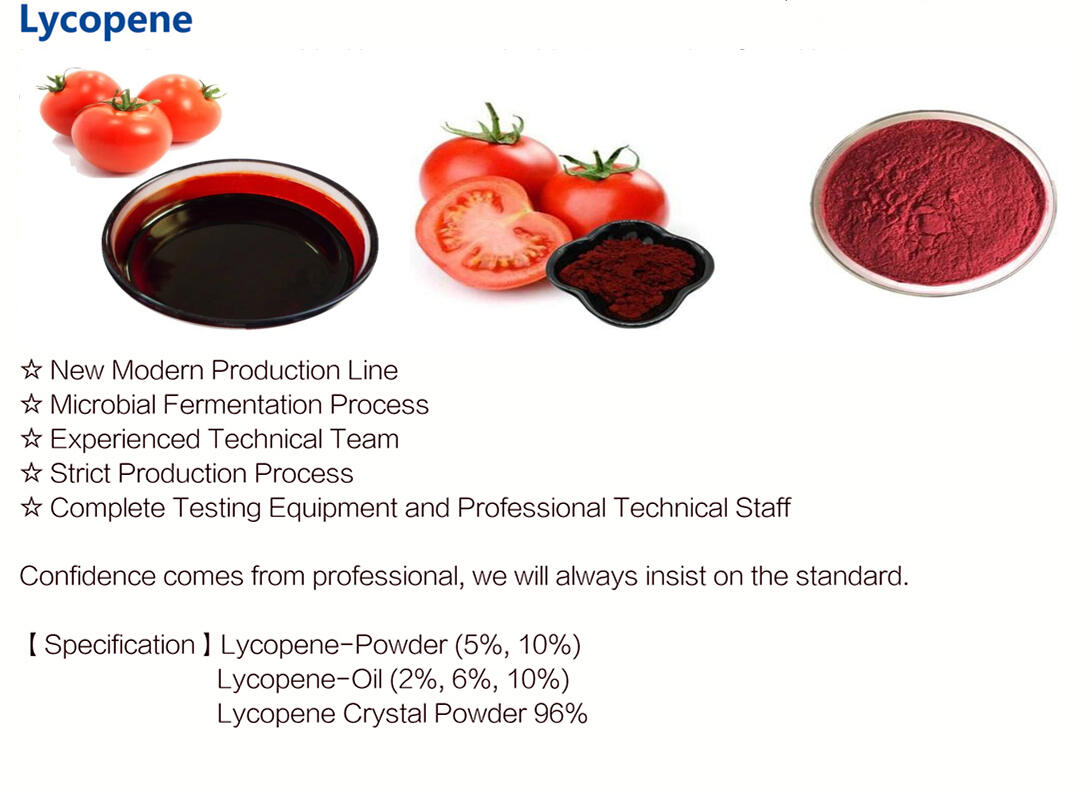Lycopene as an antioxidant
Lycopene is present in many fruits and vegetables, with tomatoes and processed tomato products being among the richest sources. This review highlights the scientific documentation of lycopene as a therapeutic agent. Lycopene may alleviate chronic diseases such as cancer and coronary heart disease. Lycopene has also been found effective in the treatment of eye diseases, male infertility, inflammation, and osteoporosis
The Basics Of Lycopene
Lycopene (pronounced LIE-co-peen) is a nutrient in the carotenoid family (where you can find lutein, zeaxanthin and many others) that’s naturally found in some plants. Lycopene provides the pigment that gives red and pink fruits their color and is known to have antioxidant properties. It’s most commonly associated with tomatoes and tomato products, which are particularly rich sources of lycopene.

What are the Benefits of Lycopene?
Lycopene is known as a powerful antioxidant and can provide many health benefits in the body. Some important benefits of lycopene:
Antioxidant Effect: Lycopene can reduce oxidative stress by fighting free radicals in the body. This can help prevent cellular damage and support overall health.
Cardiovascular Health: Regular intake of lycopene may positively affect heart health. It has the potential to regulate blood pressure and control cholesterol levels.
Eye Health: Lycopene is one of the carotenoids that protect eye health. It can reduce the risk of age-related degeneration in the eye and support visual health.
Immune System Support: Its antioxidant properties indicate that lycopene has an immune system boosting effect. This can support the body in protecting against infections.
Reducing Cancer Risk: Some research shows that lycopene may be particularly effective in reducing the risk of cancer types such as prostate, lung and stomach cancer.

Lycopene And Health
Lycopene’s primary role in human health is as an antioxidant. Antioxidants neutralize the activity of reactive compounds called free radicals, which create oxidative stress within our body. Sometimes oxidative stress can be beneficial for our body (like when we need to repair damaged tissues or fight against cancer cells), but when the amount and activity of free radicals overwhelms the protective effects of antioxidants, this uncontrolled oxidative stress can be associated with developing chronic diseases like certain types of cancer and cardiovascular disease. Lycopene’s antioxidant properties help to maintain the balance of free radical activity in the body, which may be protective against some of these conditions.
The strongest evidence of lycopene’s benefit to health is related to its blood-pressure lowering effect. Consuming more than 12 milligrams (mg) of lycopene per day has been shown to lower blood pressure, especially in people with high blood pressure.
Some observational studies have shown an association between a diet rich in lycopene and reduced risk of some types of cancer, including breast, prostate and lung cancers. However, research is inconsistent in these areas and randomized controlled trials have not demonstrated a consistent benefit to consuming lycopene from food or supplements for cancer prevention or treatment.
Although research is limited, lycopene shows promise for offering protection against the harmful effects of sun exposure on our skin. However, it is not a substitute for sunscreen, which should be used even if a person consumes a lycopene-rich diet.

Recommended Intakes
An official recommended daily intake for lycopene hasn’t been set because there hasn’t been enough research on its health effects. Consuming at least 12 mg per day of lycopene has shown a blood pressure-lowering effect in people with high blood pressure. Actual intake of lycopene for most Americans is about about 2 mg/day, or about the amount in a ½ cup of cherry tomatoes, meaning that most of us should aim to increase our intake of lycopene-rich foods.
The European Food Safety Authority has established an acceptable daily intake of 0.5 mg lycopene/kilogram body weight per day from all sources, including foods and supplements. Several forms of lycopene, including extracts and synthetically produced lycopene, are generally recognized as safe (GRAS) by the Food and Drug Administration. This means that food producers can use them as additives.
Lycopene is considered very safe to eat and the risk of consuming too much from food is very low. Hyperpigmentation of the skin, in which a person’s skin tone appears yellow or orange, has occurred in people who consumed large quantities of lycopene. This condition – sometimes called lycopenemia – can be reversed by following a low lycopene diet for a few weeks.

Food Sources Of Lycopene
Lycopene is found in red- and pink-hued fruits like tomatoes, watermelon, pink grapefruits, guava and papaya. In North America, most dietary lycopene comes from tomato products such as ketchup, tomato juice, sauce or paste. Sun-dried tomatoes, which have been dehydrated to remove their water content, are one of the most concentrated food sources of lycopene. Cooking tomatoes, which is done when making tomato juice, paste and ketchup, makes lycopene easier for our bodies to absorb compared to the lycopene found in raw tomatoes. Carotenoids like lycopene are fat-soluble, which means that they’re best absorbed when eaten with some type of fat, such as olive oil or butter.
Lycopene is FDA-approved for use as an additive in foods and beverages. It can also be found in a concentrated and isolated form in dietary supplements. However, lycopene supplements should not be used in people taking blood thinners or blood-pressure lowering medications since lycopene can alter their effectiveness. Pregnant women should also avoid using lycopene supplements because in one study, taking them was associated with preterm labor and low birth weight. Consuming lycopene from foods, however, is thought to be safe for each of these groups of people.
| Food | Serving Size | Lycopene content (mg) |
| Canned tomato puree | 1 cup | 54.4 |
| Sun-dried tomatoes | 1 cup | 24.8 |
| Tomato juice | 1 cup | 22.0 |
| Guava | 1 cup, cubes | 8.59 |
| Watermelon | 1 cup, diced | 6.89 |
| Red tomato, raw | 1 cup, chopped | 4.63 |
| Tomato paste | 1 tablespoon | 4.60 |
| Pink and red grapefruit | 1 cup, sections | 3.26 |
| Papaya | 1 cup, cubes | 2.65 |
| Ketchup | 1 tablespoon | 2.05 |
*Information derived from USDA’s Food Composition Database

Conclusion
Lycopene is a powerful antioxidant that can protect and repair the body from damage caused by a multiple diseases. You can get a great deal of it in your diet by consuming tomatoes, watermelon, and other common fruits and vegetables. One of the best ways to ensure your body absorbs the highest lycopene content possible is to add heat and healthy fats to tomatoes, such as making homemade tomato sauce for pasta. The change in lycopene molecules this causes (from linear to bent) can’t usually be found in commercially produced pasta sauce.
References
Abushita AA et al. “Change in carotenoids and antioxidant vitamins in tomato as a function of varietal and technological factors.” J Agric Food Chem., 2000, https://pubmed.ncbi.nlm.nih.gov/10888501/
Fraser GE et al. “Tomato consumption and intake of lycopene as predictors of the incidence of prostate cancer: the Adventist Health Study-2.” Cancer Causes Control, April 2020, https://pubmed.ncbi.nlm.nih.gov/32100191/
Gärtner C et al. “Lycopene is more bioavailable from tomato paste than from fresh tomatoes.” Am J Clin Nutr., July 1997, https://pubmed.ncbi.nlm.nih.gov/9209178/
Hirsh, Steven P et al. “Self-Assessed Benefits of a Prostate Health Formulation on Nocturia in Healthy Males With Mild Lower Urinary Tract Symptoms: An Open Label Study.” Global advances in health and medicine, November2020, https://www.ncbi.nlm.nih.gov/pmc/articles/PMC7705803/
Imran, Muhammad et al. “Lycopene as a Natural Antioxidant Used to Prevent Human Health Disorders.” Antioxidants, August2020, https://www.ncbi.nlm.nih.gov/pmc/articles/PMC7464847/
Send Inquiry
Related Industry Knowledge
- Hydrolyzed Krill Protein: The Science and Benefits of a Nutritional Powerhouse
- What is Resveratrol and Why it is Important?
- MSM Powder for Skin Benefits
- Purple corn extract powder made in china
- What is green coffee powder used for?
- How Black Carrot Extract Enhances Your Favorite Desserts
- Creatine vs CaHMB: The ultimate showdown for muscle gain, who has the advantage?
- Is magnesium malate good for bones?
- Is beta-glucan good for the skin?
- Explore the Nutritional Value of Butterfly Pea Powder


